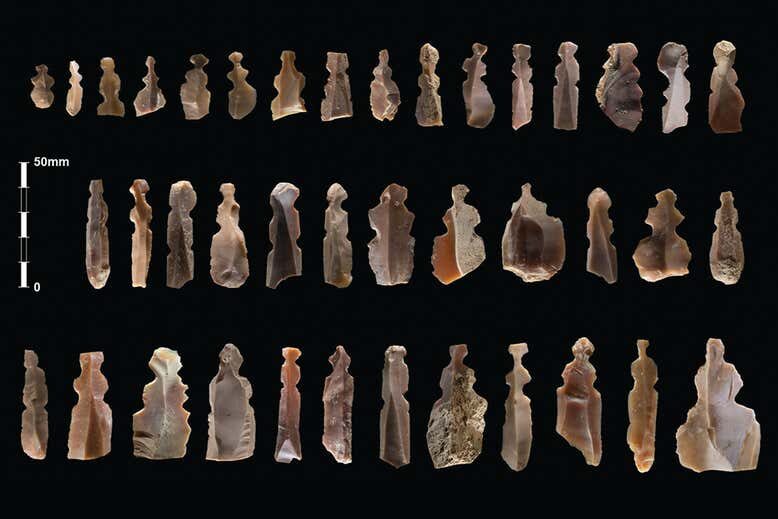
© Kharaysin archaeological teamThe potential flint figurines.
Since 2014, Juan José Ibáñez at the Milá and Fontanals Institution for Humanities Research in Spain and his colleagues have been excavating a site called Kharaysin in Jordan. It was occupied from around 9000 BC until at least 7000 BC. At this time, people who were previously hunter-gatherers were taking up settled farming. Kharaysin is one of the oldest examples of a village where people built houses and lived year-round.
"We were excavating funerary areas, a cemetery," says Ibáñez. This is where the researchers found the flint objects, each with the same distinctive shape and with two pairs of notches carved into it on either side.
"We know very well the tools that are made at that period," says Ibáñez. These artefacts didn't look like any of them.
The objects don't seem to have been used as tools, as they show no signs of wear from use. This suggests they were decorative or symbolic, says Ibáñez.
When a team member first proposed that the artefacts were
figurines representing humans, "we were kind of sceptical", says Ibáñez. However, the team has since become convinced that they are depictions of people, albeit crude ones. "They made two notches in one side, one representing the neck probably and the other the hip," says Ibáñez (
Antiquity, DOI:
10.15184/aqy.2020.78).
"This is an intriguing hypothesis, but humans are very good at seeing faces in natural objects," says April Nowell at the University of Victoria in Canada. "That is why there are so many stories about the man in the moon, and why every now and again people see Jesus in a piece of toast. If someone showed you that photograph of the 'figurines' without knowing the subject of the paper, you would most likely have said that this is a photograph of stone tools."
It is "very possible" that the artefacts are figurines, but "they might not represent humans at all", says Allison Tripp at Chaffey College in California. "What I think is certain is that they are a form of symbolic communication," she says.
For Ibáñez, the fact that the artefacts were only found in the cemetery suggests that people used them in funerary rituals. At this time, bodies were buried in pits, but they were later dug up and certain bones were removed and reburied elsewhere.
This suggests a reverence for ancestors and perhaps a desire to consult with them through rituals, says Ibáñez. He says the figurines may have played a role in this.

Reader Comments
We might look at training objects.
R.C. RC